Microstructure and Mechanical Properties of Hybrid Pure Al/B4C/Microsilica Composites Produced by Ultrasonically Assisted Stir Casting
Abstract
1. Introduction
2. Materials and Methods
2.1. Experimental Overview
2.2. Powders: SEM/EDS Characterization
2.3. Material Characterization
3. Results and Discussion
3.1. Microstructural Observations
3.2. Mechanical Properties
4. Conclusions
Author Contributions
Funding
Data Availability Statement
Acknowledgments
Conflicts of Interest
References
- Ujah, C.O.; Kallon, D.V.V. Trends in Aluminium Matrix Composite Development. Crystals 2022, 12, 1357. [Google Scholar] [CrossRef]
- Kar, A.; Sharma, A.; Kumar, S. A Critical Review on Recent Advancements in Aluminium-Based Metal Matrix Composites. Crystals 2024, 14, 412. [Google Scholar] [CrossRef]
- Patel, S.K.; Shi, L. Recent Advances in Ceramic-Reinforced Aluminum Metal Matrix Composites: A Review. Alloys 2025, 4, 18. [Google Scholar] [CrossRef]
- Mirza, F.A.; Chen, D.L. A Unified Model for the Prediction of Yield Strength in Particulate-Reinforced Metal Matrix Nanocomposites. Materials 2015, 8, 5138–5153. [Google Scholar] [CrossRef]
- Singhal, V.; Shelly, D.; Babbar, A.; Lee, S.-Y.; Park, S.-J. Review of Wear and Mechanical Characteristics of Al-Si Alloy Matrix Composites Reinforced with Natural Minerals. Lubricants 2024, 12, 350. [Google Scholar] [CrossRef]
- Abishkenov, M.; Tavshanov, I.; Lutchenko, N.; Amanzholov, N.; Kalmyrzayev, D.; Ashkeyev, Z.; Nogaev, K.; Kydyrbayeva, S.; Abdirashit, A. Improving Mechanical Properties of Low-Quality Pure Aluminum by Minor Reinforcement with Fine B4C Particles and T6 Heat Treatment. Appl. Sci. 2024, 14, 10773. [Google Scholar] [CrossRef]
- Channar, H.R.; Ullah, B.; Naseem, M.S.; Akhter, J.; Mehmood, A.; Aamir, M. Mechanical Properties and Microstructural Investigation of AA2024-T6 Reinforced with Al2O3 and SiC Metal Matrix Composites. Eng 2024, 5, 3023–3032. [Google Scholar] [CrossRef]
- Ananiadis, E.A.; Karantzalis, A.E.; Sfikas, A.K.; Georgatis, E.; Matikas, T.E. Aluminium Matrix Composites Reinforced with AlCrFeMnNi HEA Particulates: Microstructure, Mechanical and Corrosion Properties. Materials 2023, 16, 5491. [Google Scholar] [CrossRef] [PubMed]
- Blanco, D.; Rubio, E.M.; Lorente-Pedreille, R.M.; Sáenz-Nuño, M.A. Sustainable Processes in Aluminium, Magnesium, and Titanium Alloys Applied to the Transport Sector: A Review. Metals 2022, 12, 9. [Google Scholar] [CrossRef]
- Akbari, T.; Ansari, A.; Rahimi Pishbijari, M. Influence of aluminum alloys on protection performance of metal matrix composite armor reinforced with ceramic particles under ballistic impact. Ceram. Int. 2023, 49, 30937–30950. [Google Scholar] [CrossRef]
- Okokpujie, I.P.; Tartibu, L.K. Aluminum Alloy Reinforced with Agro-Waste, and Eggshell as Viable Material for Wind Turbine Blade to Annex Potential Wind Energy: A Review. J. Compos. Sci. 2023, 7, 161. [Google Scholar] [CrossRef]
- Abishkenov, M.; Tavshanov, I.; Lutchenko, N.; Nogayev, K.; Ashkeyev, Z.; Kulidan, S. Microstructural Evolution and Mechanical Properties of Hybrid Al6060/TiB2–MWCNT Composites Fabricated by Ultrasonically Assisted Stir Casting and Radial-Shear Rolling. Appl. Sci. 2025, 15, 10427. [Google Scholar] [CrossRef]
- Oyewo, A.T.; Oluwole, O.O.; Ajide, O.O.; Omoniyi, T.E.; Hussain, M. A summary of current advancements in hybrid composites based on aluminium matrix in aerospace applications. Hybrid Adv. 2024, 5, 100117. [Google Scholar] [CrossRef]
- Boppana, S.B.; Dayanand, S.; Murthy, B.V.; Nagaral, M.; Telagu, A.; Kumar, V.; Auradi, V. Development and Mechanical Characterisation of Al6061-Al2O3-Graphene Hybrid Metal Matrix Composites. J. Compos. Sci. 2021, 5, 155. [Google Scholar] [CrossRef]
- Ashrafi, N.; Mohamed Ariff, A.H.; Jung, D.-W.; Sarraf, M.; Foroughi, J.; Sulaiman, S.; Hong, T.S. Magnetic, Electrical, and Physical Properties Evolution in Fe3O4 Nanofiller Reinforced Aluminium Matrix Composite Produced by Powder Metallurgy Method. Materials 2022, 15, 4153. [Google Scholar] [CrossRef] [PubMed]
- Rogers, S.; Dargusch, M.; Kent, D. Impacts of Temperature and Time on Direct Nitridation of Aluminium Powders for Preparation of AlN Reinforcement. Materials 2023, 16, 1583. [Google Scholar] [CrossRef] [PubMed]
- Mathimurugan, N.; Vaishnav, V.; Praveen Kumar, R.; Boobalan, P.; Nandha, S.; Chenrayan, V.; Shahapurkar, K.; Tirth, V.; Alarifi, I.M.; Eldirderi, M.M.A.; et al. Room and High Temperature Tensile Responses of Tib2-Graphene Al 7075 Hybrid Composite Processed through Squeeze Casting. Nanomaterials 2022, 12, 3124. [Google Scholar] [CrossRef]
- Ramanathan, A.; Krishnan, P.K.; Muraliraja, R. A review on the production of metal matrix composites through stir casting–Furnace design, properties, challenges, and research opportunities. J. Manuf. Process. 2019, 42, 213–245. [Google Scholar] [CrossRef]
- Bhowmik, A.; Kumar, R.; Beemkumar, N.; Kumar, A.V.; Singh, G.; Kulshreshta, A.; Mann, V.S.; Santhosh, A.J. Casting of particle reinforced metal matrix composite by liquid state fabrication method: A review. Results Eng. 2024, 24, 103152. [Google Scholar] [CrossRef]
- Shivalingaiah, K.; Nagarajaiah, V.; Selvan, C.P.; Kariappa, S.T.; Chandrashekarappa, N.G.; Lakshmikanthan, A.; Chandrashekarappa, M.P.G.; Linul, E. Stir Casting Process Analysis and Optimization for Better Properties in Al-MWCNT-GR-Based Hybrid Composites. Metals 2022, 12, 1297. [Google Scholar] [CrossRef]
- Sharma, S.K.; Gajević, S.; Sharma, L.K.; Pradhan, R.; Sharma, Y.; Miletić, I.; Stojanović, B. Progress in Aluminum-Based Composites Prepared by Stir Casting: Mechanical and Tribological Properties for Automotive, Aerospace, and Military Applications. Lubricants 2024, 12, 421. [Google Scholar] [CrossRef]
- Wang, Y.; Zhang, J. A Review of the Friction and Wear Behavior of Particle-Reinforced Aluminum Matrix Composites. Lubricants 2023, 11, 317. [Google Scholar] [CrossRef]
- Yadav, P.; Ranjan, A.; Kumar, H.; Mishra, A.; Yoon, J. A Contemporary Review of Aluminium MMC Developed through Stir-Casting Route. Materials 2021, 14, 6386. [Google Scholar] [CrossRef]
- Riedel, E.; Liepe, M.; Scharf, S. Simulation of Ultrasonic Induced Cavitation and Acoustic Streaming in Liquid and Solidifying Aluminum. Metals 2020, 10, 476. [Google Scholar] [CrossRef]
- Zhang, Y.; Li, R.; Li, X.; Yang, Y.; Chen, P.; Dong, F.; Jiang, R. Possible Effects and Mechanisms of Ultrasonic Cavitation on Oxide Inclusions during Direct-Chill Casting of an Al Alloy. Metals 2018, 8, 814. [Google Scholar] [CrossRef]
- Dybalska, A.; Caden, A.; Griffiths, W.D.; Nashwan, Z.; Bojarevics, V.; Djambazov, G.; Tonry, C.E.H.; Pericleous, K.A. Enhancement of Mechanical Properties of Pure Aluminium through Contactless Melt Sonicating Treatment. Materials 2021, 14, 4479. [Google Scholar] [CrossRef]
- Li, Z.; Jiang, R.; Li, X.; Jia, X.; Zhang, L. Microstructural Evolution and Wear Behavior of SiCp/7085 Composites Manufactured by Ultrasonic Stirring Casting. Metals 2020, 10, 650. [Google Scholar] [CrossRef]
- Abishkenov, M.; Tavshanov, I.; Lutchenko, N.; Nogayev, K.; Ashkeyev, Z.; Kulidan, S. Microstructure and Mechanical Properties of Al6060/TiB2 Aluminum Matrix Composites Produced via Ultrasonically Assisted Stir Casting and Radial-Shear Rolling. J. Manuf. Mater. Process. 2025, 9, 309. [Google Scholar] [CrossRef]
- Zubcak, M.; Soltes, J.; Zimina, M.; Weinberger, T.; Enzinger, N. Investigation of Al-B4C Metal Matrix Composites Produced by Friction Stir Additive Processing. Metals 2021, 11, 2020. [Google Scholar] [CrossRef]
- Liu, Y.; Xie, J.; Peng, H.; Liu, C.; Ma, D.; Leng, Y. Effects of Boron Addition on Microstructure and Mechanical Properties of B4C/Al Composites Fabricated by Pressureless Infiltration. Metals 2025, 15, 919. [Google Scholar] [CrossRef]
- Shin, S.; Lee, D.; Lee, Y.-H.; Ko, S.; Park, H.; Lee, S.-B.; Cho, S.; Kim, Y.; Lee, S.-K.; Jo, I. High Temperature Mechanical Properties and Wear Performance of B4C/Al7075 Metal Matrix Composites. Metals 2019, 9, 1108. [Google Scholar] [CrossRef]
- Madhukar, P.; Mishra, V.; Selvaraj, N.; Rao, C.S.P.; Gonal Basavaraja, V.K.; Seetharam, R.; Chavali, M.; Mohammad, F.; Soleiman, A.A. Influence of ultrasonic vibration towards the Microstructure Refinement and Particulate Distribution of AA7150-B4C Nanocomposites. Coatings 2022, 12, 365. [Google Scholar] [CrossRef]
- Samal, P.; Raj, H.; Meher, A.; Surekha, B.; Vundavilli, P.R.; Sharma, P. Synergistic Effect of B4C and Multi-Walled CNT on Enhancing the Tribological Performance of Aluminum A383 Hybrid Composites. Lubricants 2024, 12, 213. [Google Scholar] [CrossRef]
- Tasci, U. Microstructure, Mechanical Strength, and Tribological Behavior of B4C/WS2-Hybrid-Reinforced B319 Aluminum Matrix Composites. Lubricants 2025, 13, 247. [Google Scholar] [CrossRef]
- Malaki, M.; Fadaei Tehrani, A.; Niroumand, B.; Gupta, M. Wettability in Metal Matrix Composites. Metals 2021, 11, 1034. [Google Scholar] [CrossRef]
- Abishkenov, M.; Tavshanov, I.; Lutchenko, N.; Nogaev, K.; Kalmyrzayev, D.; Abdirashit, A.; Aikenbayeva, N. Effect of Minor Reinforcement with Ultrafine Industrial Microsilica Particles and T6 Heat Treatment on Mechanical Properties of Aluminum Matrix Composites. Appl. Sci. 2025, 15, 1329. [Google Scholar] [CrossRef]
- Dash, S.S.; Chen, D. A Review on Processing–Microstructure–Property Relationships of Al-Si Alloys: Recent Advances in Deformation Behavior. Metals 2023, 13, 609. [Google Scholar] [CrossRef]
- Msebawi, M.S.; Leman, Z.; Shamsudin, S.; Tahir, S.M.; Jaafar, C.N.A.; Ariff, A.H.M.; Zahari, N.I.; Rady, M.H. The Effects of CuO and SiO2 on Aluminum AA6061 Hybrid Nanocomposite as Reinforcements: A Concise Review. Coatings 2021, 11, 972. [Google Scholar] [CrossRef]
- Baisanov, A.; Vorobkalo, N.; Shabanov, Y.; Zobnin, N.; Baisanova, A.; Sharieva, S.; Akuov, A.; Samuratov, Y.; Ibrakhimova, Z.; Zhumagaliev, T. Optimization of the Properties of Microsilica-Based Composite Briquettes Depending on Their Granulometry. J. Compos. Sci. 2024, 8, 439. [Google Scholar] [CrossRef]
- Baisanov, A.; Vorobkalo, N.; Shabanov, Y.; Mussin, A.; Sharieva, S.; Makishev, A. Test Results of Crystalline Silicon Melting Process from Briquetted Monocharge Obtained from Microsilica. Processes 2024, 12, 1911. [Google Scholar] [CrossRef]
- Sakir, S.; Raman, S.N.; Safiuddin, M.; Kaish, A.B.M.A.; Mutalib, A.A. Utilization of By-Products and Wastes as Supplementary Cementitious Materials in Structural Mortar for Sustainable Construction. Sustainability 2020, 12, 3888. [Google Scholar] [CrossRef]
- Zhao, C.; Li, B.; Li, K.; Li, Z. Research on Mechanical Properties of Silica Fume Cementitious Materials Excited by Wet Grinding Methods. Buildings 2024, 14, 3757. [Google Scholar] [CrossRef]
- Harper, M. Recent Advances in Occupational Exposure Assessment of Aerosols. Int. J. Environ. Res. Public Health 2020, 17, 6820. [Google Scholar] [CrossRef]
- Xie, Z.; Jiang, R.; Li, X.; Zhang, L.; Li, A.; He, Z. Microstructural evolution and mechanical properties of TiB2/2195 composites fabricated by ultrasonic-assisted in-situ casting. Ultrason. Sonochem. 2022, 90, 106203. [Google Scholar] [CrossRef]
- Kareem, A.; Qudeiri, J.A.; Abdudeen, A.; Ahammed, T.; Ziout, A. A Review on AA 6061 Metal Matrix Composites Produced by Stir Casting. Materials 2021, 14, 175. [Google Scholar] [CrossRef]
- Zhukov, I.A.; Kozulin, A.A.; Khrustalyov, A.P.; Kahidze, N.I.; Khmeleva, M.G.; Moskvichev, E.N.; Lychagin, D.V.; Vorozhtsov, A.B. Pure Aluminum Structure and Mechanical Properties Modified by Al2O3 Nanoparticles and Ultrasonic Treatment. Metals 2019, 9, 1199. [Google Scholar] [CrossRef]
- Gudipudi, S.; Nagamuthu, S.; Subbian, K.S.; Chilakalapalli, S.P.R. Enhanced mechanical properties of AA6061-B4C composites developed by a novel ultra-sonic assisted stir casting. Eng. Sci. Technol. Int. J. 2020, 23, 1233–1243. [Google Scholar] [CrossRef]
- Sree Manu, K.M.; Sreeraj, K.; Rajan, T.P.D.; Shereema, R.M.; Pai, B.C.; Arun, B. Structure and properties of modified compocast microsilica reinforced aluminum matrix composite. Mater. Des. 2015, 88, 294–301. [Google Scholar] [CrossRef]
- Kuz’min, M.P.; Larionov, L.M.; Chu, P.K.; Qasim, A.M.; Kuz’mina, M.Y.; Kondratiev, V.V.; Kuz’mina, A.S.; Ran, J.Q. New Methods of Obtaining Al–Si Alloys Using Amorphous Microsilica. Int. J. Met. 2020, 14, 207–217. [Google Scholar] [CrossRef]
- Abishkenov, M.; Ashkeyev, Z.; Nogaev, K.; Bestembek, Y.; Azimbayev, K.; Tavshanov, I. On the possibility of implementing a simple shear in the cross-section of metal materials during caliber rolling. Eng. Solid Mech. 2023, 11, 253–262. [Google Scholar] [CrossRef]
- Parasuraman, B.; Michael, A.X. Effect of T6 Tempering on the Wear and Corrosive Properties of Graphene and B4C Reinforced Al6061 Matrix Composites. J. Manuf. Mater. Process. 2025, 9, 82. [Google Scholar] [CrossRef]
- Konstanty, J.; Tyrala, D. Particle Sizing and Surface Area Measurements: A Comparative Assessment of Commercial Air Permeability and Laser Light Diffraction Instruments. Appl. Sci. 2024, 14, 4802. [Google Scholar] [CrossRef]
- ASTM E8/E8M-16ae1; Standard Test Methods for Tension Testing of Metallic Materials. ASTM International: West Conshohocken, PA, USA, 2021. [CrossRef]
- ASTM E384-22; Standard Test Method for Microindentation Hardness of Materials. ASTM International: West Conshohocken, PA, USA, 2022. [CrossRef]
- Krupiński, M.; Gruszka, M.; Pakieła, W.; Labisz, K.; Wierzbicki, Ł. Crystallization Kinetics of Sr-Modified Precipitation Hardening Al-Si-Cu Alloys. Appl. Sci. 2025, 15, 1371. [Google Scholar] [CrossRef]
- Mrówka-Nowotnik, G.; Boczkal, G.; Nabel, D. Kinetics of Precipitation Hardening Phases in Recycled 2017A Aluminum Alloy. Materials 2025, 18, 1235. [Google Scholar] [CrossRef]
- Czerwinski, F. Thermal Stability of Aluminum Alloys. Materials 2020, 13, 3441. [Google Scholar] [CrossRef]
- Zeybek, Y.; Kayış, C.; Diler, E.A. Improving Electrical Conductivity of Commercially Pure Aluminium: The Synergistic Effect of AlB8 Master Alloy and Heat Treatment. Materials 2025, 18, 364. [Google Scholar] [CrossRef]
- Schwarze, C.; Darvishi Kamachali, R.; Steinbach, I. Phase-field study of zener drag and pinning of cylindrical particles in polycrystalline materials. Acta Mater. 2016, 106, 59–65. [Google Scholar] [CrossRef]
- Geng, R.; Qiu, F.; Jiang, Q.-C. Reinforcement in Al Matrix Composites: A Review of Strengthening Behavior of Nano-Sized Particles. Adv. Eng. Mater. 2018, 20, 1701089. [Google Scholar] [CrossRef]
- Zupanič, F.; Žist, S.; Albu, M.; Letofsky-Papst, I.; Burja, J.; Vončina, M.; Bončina, T. Dispersoids in Al-Mg-Si Alloy AA 6086 Modified by Sc and Y. Materials 2023, 16, 2949. [Google Scholar] [CrossRef]
- Al-Fadhalah, K.; Asi, F. Aging Behavior of Aluminum Alloy 6082 Subjected to Friction Stir Processing. Crystals 2018, 8, 337. [Google Scholar] [CrossRef]
- Kuczek, Ł.; Żaba, K.; Trzepieciński, T.; Wąsikowski, M.; Balcerzak, M.; Sitek, R. Influence of Heat Treatment on Properties and Microstructure of EN AW-6082 Aluminium Alloy Drawpieces After Single-Point Incremental Sheet Forming. Appl. Sci. 2025, 15, 783. [Google Scholar] [CrossRef]
- Singhal, V.; Shelly, D.; Saxena, A.; Gupta, R.; Verma, V.K.; Jain, A. Study of the Influence of Nanoparticle Reinforcement on the Mechanical and Tribological Performance of Aluminum Matrix Composites—A Review. Lubricants 2025, 13, 93. [Google Scholar] [CrossRef]
- Emadinia, O.; Vieira, M.T.; Vieira, M.F. Effect of Reinforcement Type and Dispersion on the Hardening of Sintered Pure Aluminium. Metals 2018, 8, 786. [Google Scholar] [CrossRef]
- Dong, S.; Yuan, H.; Cheng, X.; Zhao, X.; Yang, M.; Fan, Y.; Cao, X. Improved Friction and Wear Properties of Al6061-Matrix Composites Reinforced by Cu-Ni Double-Layer-Coated Carbon Fibers. Metals 2020, 10, 1542. [Google Scholar] [CrossRef]
- Rativa-Parada, W.; Nilufar, S. Influence of Heat Treatment on Microstructure, Mechanical Properties, and Damping Behavior of 2024 Aluminum Matrix Composites Reinforced by Carbon Nanoparticles. Nanomaterials 2024, 14, 1342. [Google Scholar] [CrossRef]
- Chattrakul, K.; Sornsuwit, N.; Muangnoy, P. Effect of Heat Treatment on Mechanical Properties and Thermal Expansion of Al6063-SiC-Graphite, Molybdenum Disulfide Hybrid Composite. Processes 2024, 12, 2464. [Google Scholar] [CrossRef]
- García Arango, N.; Schuster, R.; Abart, R.; Povoden-Karadeniz, E. Microanalysis-Based Simulation of Heterogeneous Dispersoid Distribution in an Al Alloy After the Homogenization Stage. Crystals 2025, 15, 695. [Google Scholar] [CrossRef]
- Gomes, R.; Soares, G.; Madureira, R.; Silva, R.P.; Silva, J.; Neto, R.; Reis, A.; Fernandes, C. Development of Heat Treatments for Structural Parts in Aluminium Alloys Produced by High-Pressure Die Casting (HPDC). Metals 2024, 14, 1059. [Google Scholar] [CrossRef]




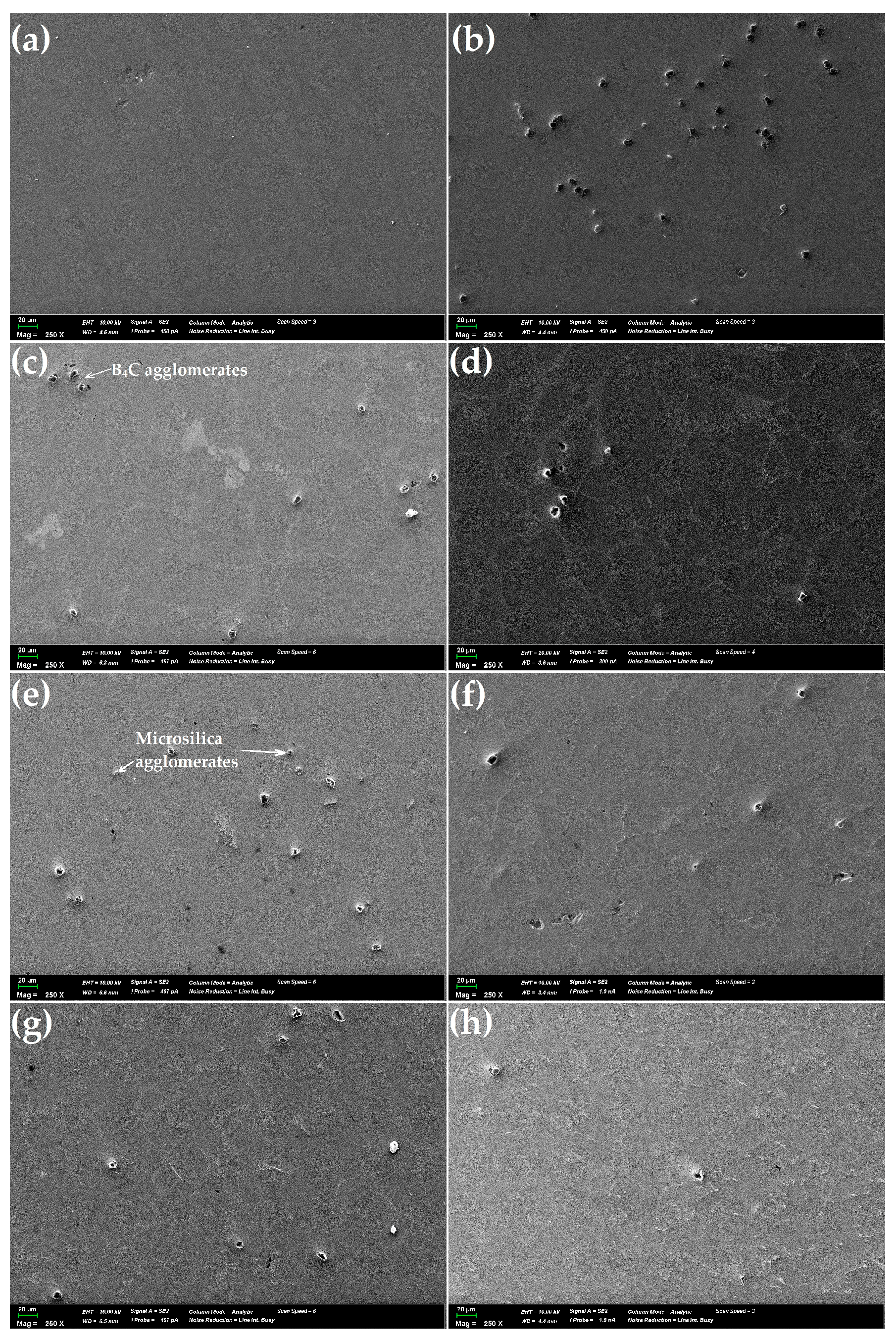
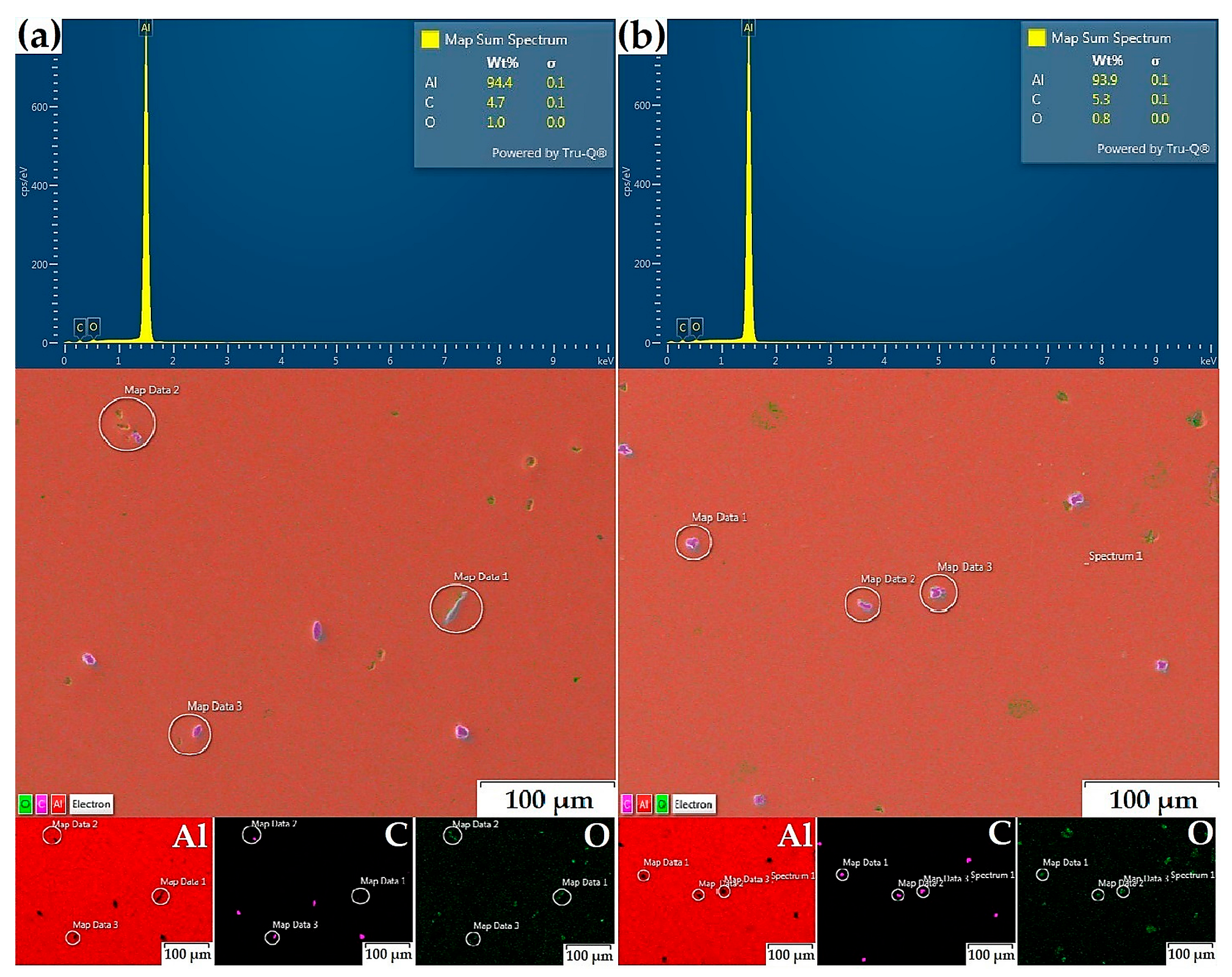
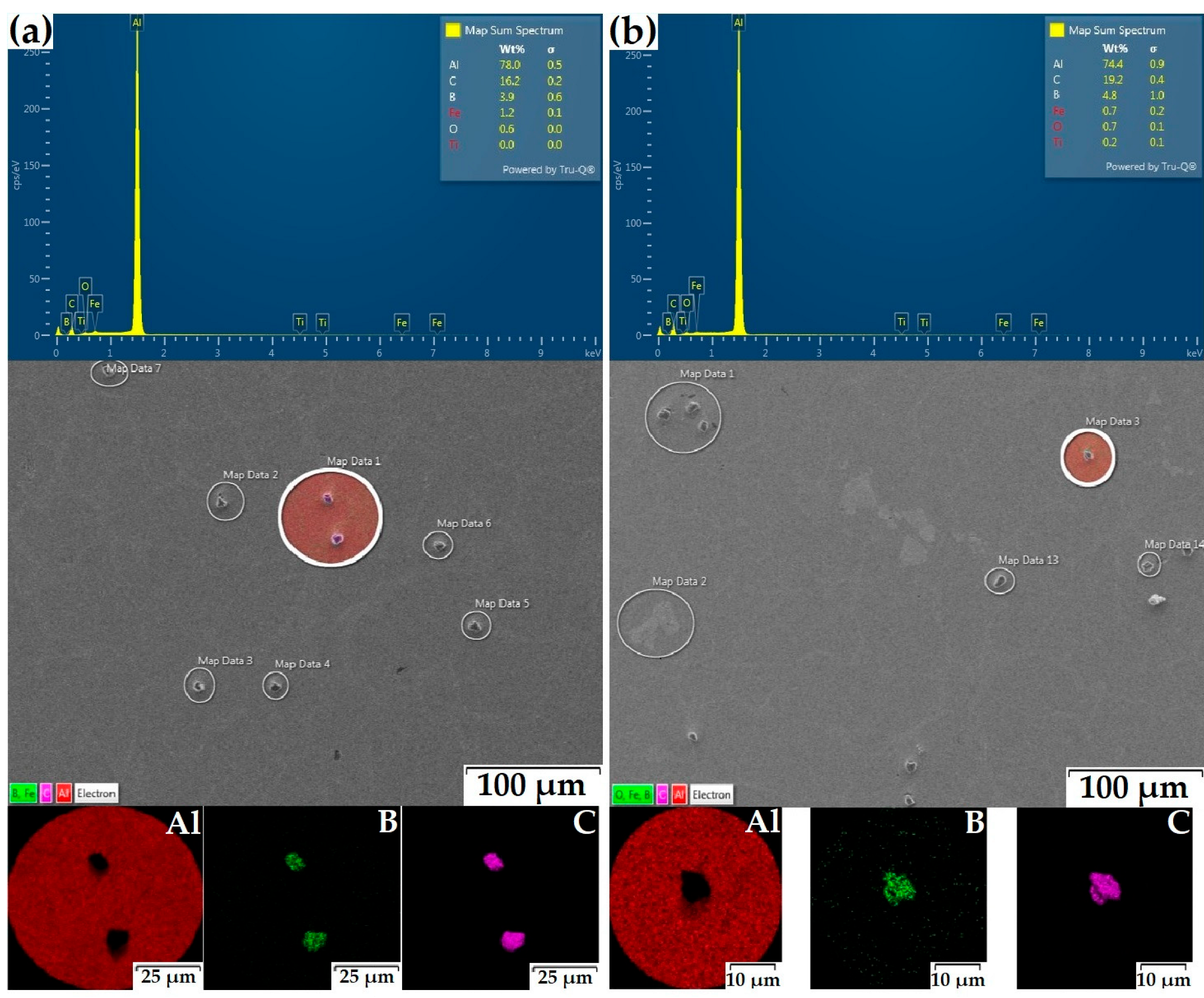


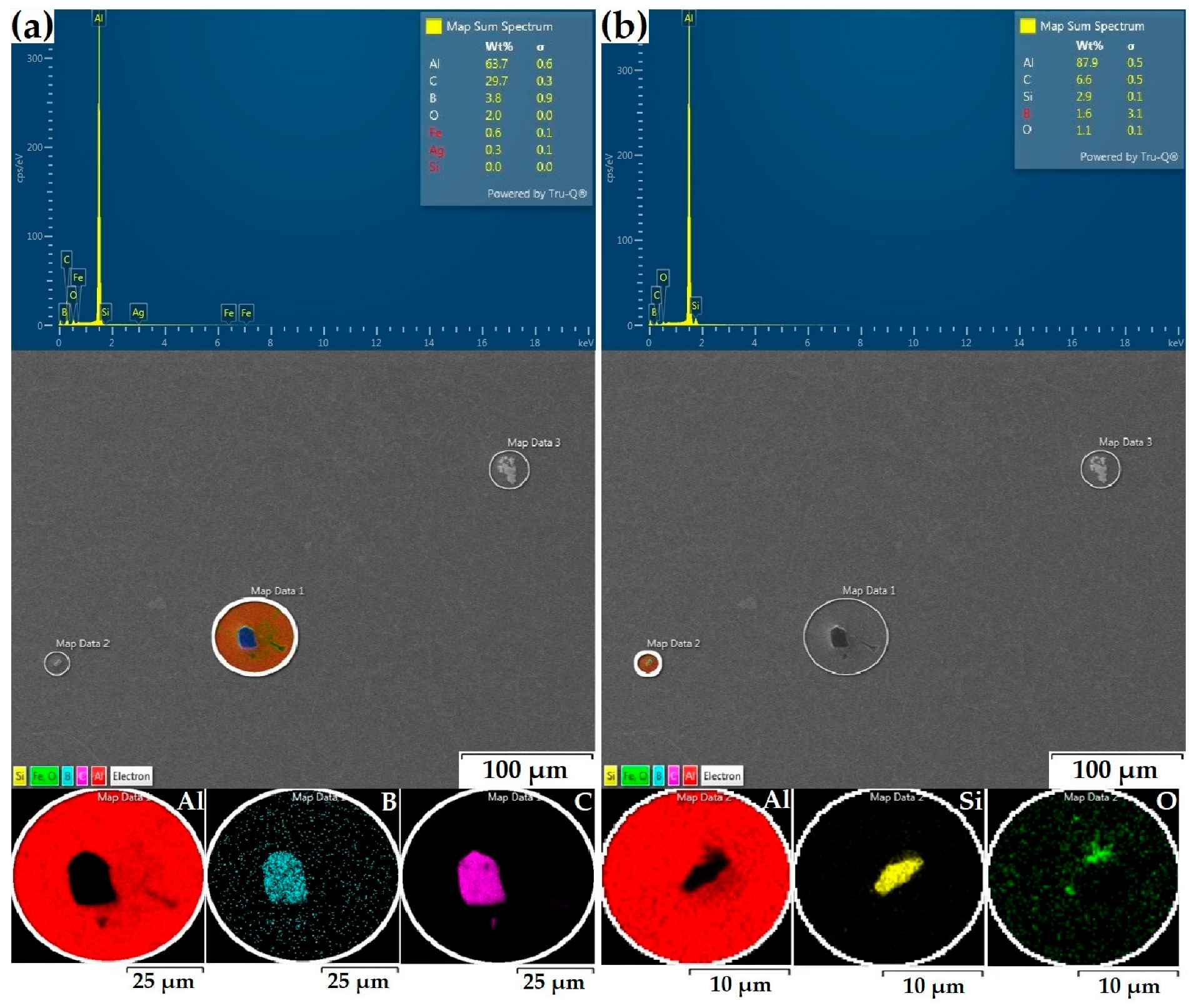


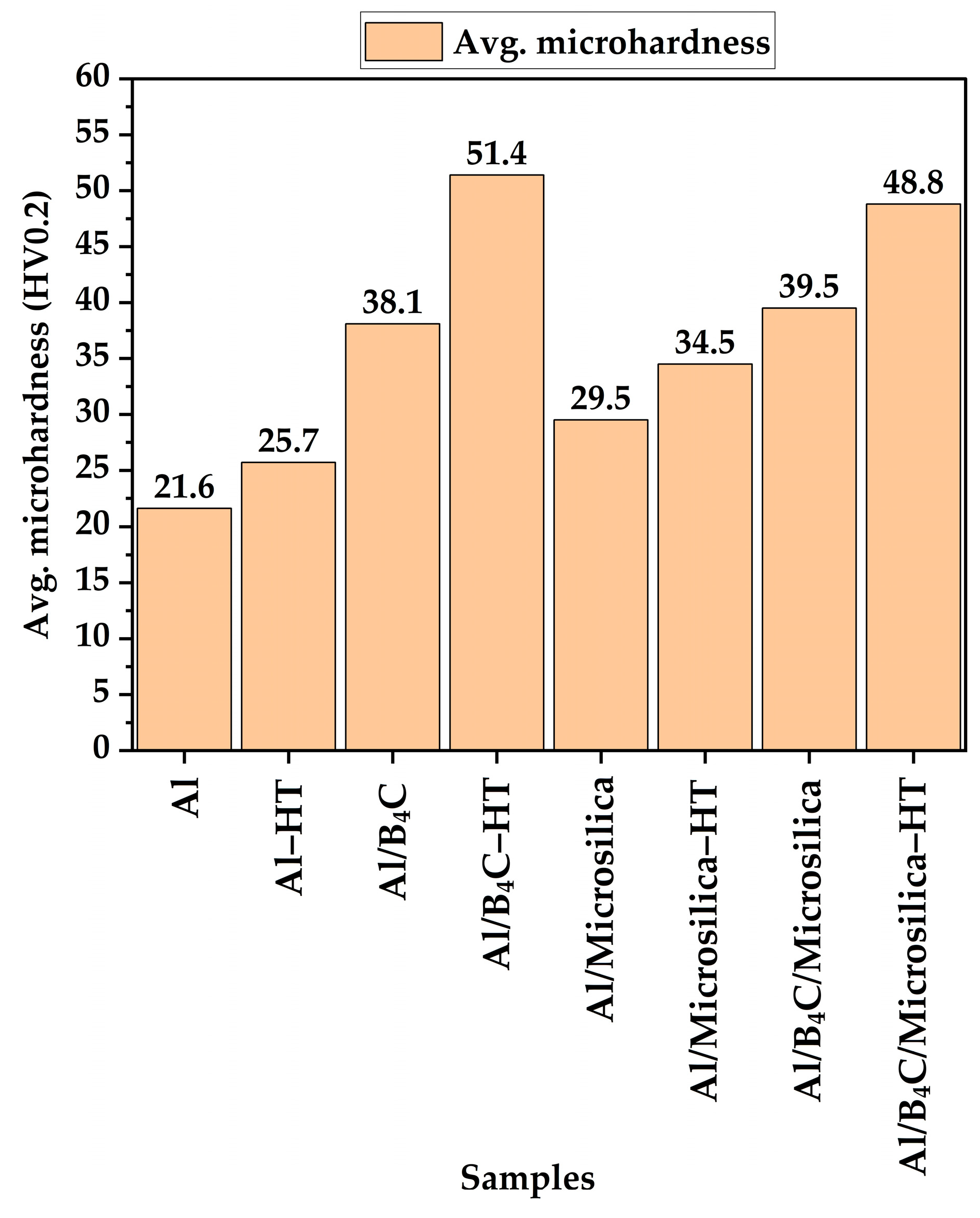
| Nomenclature | Designation | Pure Al (wt%) | B4C (wt%) | Microsilica (wt%) |
|---|---|---|---|---|
| Pure Al | Al | 100 | 0 | 0 |
| Pure Al–HT | Al–HT | 100 | 0 | 0 |
| Pure Al/1 wt% B4C | Al/B4C | 99 | 1 | 0 |
| Pure Al/1 wt% B4C–HT | Al/B4C–HT | 99 | 1 | 0 |
| Pure Al/1 wt% Microsilica | Al/Microsilica | 99 | 0 | 1 |
| Pure Al/1 wt% Microsilica–HT | Al/Microsilica–HT | 99 | 0 | 1 |
| Pure Al/0.5 wt% B4C/0.5 wt% Microsilica | Al/B4C/Microsilica | 99 | 0.5 | 0.5 |
| Pure Al/0.5 wt% B4C/0.5 wt% Microsilica–HT | Al/B4C/Microsilica–HT | 99 | 0.5 | 0.5 |
Disclaimer/Publisher’s Note: The statements, opinions and data contained in all publications are solely those of the individual author(s) and contributor(s) and not of MDPI and/or the editor(s). MDPI and/or the editor(s) disclaim responsibility for any injury to people or property resulting from any ideas, methods, instructions or products referred to in the content. |
© 2025 by the authors. Licensee MDPI, Basel, Switzerland. This article is an open access article distributed under the terms and conditions of the Creative Commons Attribution (CC BY) license (https://creativecommons.org/licenses/by/4.0/).
Share and Cite
Abishkenov, M.; Tavshanov, I.; Nogayev, K.; Gelmanova, Z.; Kamarova, S.; Yerzhanov, A. Microstructure and Mechanical Properties of Hybrid Pure Al/B4C/Microsilica Composites Produced by Ultrasonically Assisted Stir Casting. Crystals 2025, 15, 973. https://doi.org/10.3390/cryst15110973
Abishkenov M, Tavshanov I, Nogayev K, Gelmanova Z, Kamarova S, Yerzhanov A. Microstructure and Mechanical Properties of Hybrid Pure Al/B4C/Microsilica Composites Produced by Ultrasonically Assisted Stir Casting. Crystals. 2025; 15(11):973. https://doi.org/10.3390/cryst15110973
Chicago/Turabian StyleAbishkenov, Maxat, Ilgar Tavshanov, Kairosh Nogayev, Zoja Gelmanova, Saule Kamarova, and Almas Yerzhanov. 2025. "Microstructure and Mechanical Properties of Hybrid Pure Al/B4C/Microsilica Composites Produced by Ultrasonically Assisted Stir Casting" Crystals 15, no. 11: 973. https://doi.org/10.3390/cryst15110973
APA StyleAbishkenov, M., Tavshanov, I., Nogayev, K., Gelmanova, Z., Kamarova, S., & Yerzhanov, A. (2025). Microstructure and Mechanical Properties of Hybrid Pure Al/B4C/Microsilica Composites Produced by Ultrasonically Assisted Stir Casting. Crystals, 15(11), 973. https://doi.org/10.3390/cryst15110973






